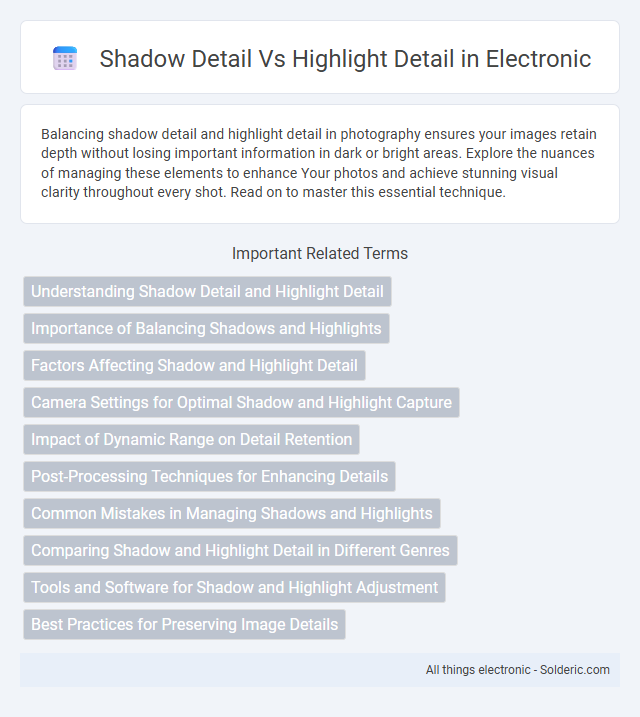Balancing shadow detail and highlight detail in photography ensures your images retain depth without losing important information in dark or bright areas. Explore the nuances of managing these elements to enhance Your photos and achieve stunning visual clarity throughout every shot. Read on to master this essential technique.
Comparison Table
| Aspect | Shadow Detail | Highlight Detail |
|---|---|---|
| Definition | Visibility and clarity of dark areas in an image | Retention of information and texture in bright areas |
| Purpose | Reveal hidden features in low-light zones | Prevent bright areas from appearing washed out |
| Common Issues | Noise and loss of detail in dark zones | Blown-out highlights and missing texture |
| Adjustment Tools | Shadow sliders, curves, exposure controls | Highlight sliders, tone mapping, HDR techniques |
| Impact on Image Quality | Improves depth and dimension in shadows | Maintains realism and prevents overexposure |
Understanding Shadow Detail and Highlight Detail
Shadow detail reveals the textures and nuances in the darkest parts of an image, allowing you to see what might otherwise be hidden in black areas. Highlight detail captures the fine information in the brightest parts, preventing overexposure and preserving subtlety in light regions. Mastering both shadow and highlight detail is essential for balanced exposure and a realistic, dynamic photograph.
Importance of Balancing Shadows and Highlights
Balancing shadow detail and highlight detail is crucial for creating images with a natural and dynamic range that accurately represents your subject. Properly preserving shadow detail prevents loss of texture in dark areas, while maintaining highlight detail avoids blown-out bright spots, ensuring visual clarity and depth. Your ability to control this balance directly impacts the overall quality and realism of photographic or video content.
Factors Affecting Shadow and Highlight Detail
Shadow detail and highlight detail in photography depend heavily on factors such as dynamic range, sensor sensitivity, and lighting conditions. The camera's dynamic range determines how well it captures nuances in the darkest shadows and brightest highlights without losing information. Your exposure settings and post-processing techniques also play crucial roles in preserving these details and balancing the overall image quality.
Camera Settings for Optimal Shadow and Highlight Capture
Adjusting the camera's dynamic range settings and exposure compensation is essential for capturing optimal shadow and highlight detail in photography. Utilizing features such as HDR mode and custom tone curve adjustments helps preserve details in both dark shadows and bright highlights, preventing loss of information. Manual control of ISO, shutter speed, and aperture further enhances the balance between shadow depth and highlight clarity.
Impact of Dynamic Range on Detail Retention
Dynamic range significantly influences detail retention by determining the spectrum of light intensities a sensor can capture, affecting both shadow detail and highlight detail. Higher dynamic range allows cameras to preserve intricate textures in shadowy areas while avoiding blown-out highlights, resulting in balanced image quality. Limited dynamic range causes loss of information in dark regions and overexposed areas, reducing overall image detail and clarity.
Post-Processing Techniques for Enhancing Details
Post-processing techniques for enhancing shadow and highlight detail utilize tools like curves and selective masking to recover information lost in underexposed or overexposed areas. High dynamic range (HDR) imaging combines multiple exposures to balance shadow and highlight details, preserving texture and color accuracy. Advanced software algorithms also employ local contrast adjustments and luminance mapping to enhance detail clarity without introducing noise or artifacts.
Common Mistakes in Managing Shadows and Highlights
Common mistakes in managing shadows and highlights include overcorrecting, which leads to unnatural contrast and loss of detail in both areas. Ignoring subtle gradations causes clipping, where shadow or highlight information is irreversibly lost, reducing image depth. Your editing should preserve texture by carefully balancing exposure adjustments to maintain realism and avoid harsh transitions.
Comparing Shadow and Highlight Detail in Different Genres
Shadow detail and highlight detail play crucial roles in shaping the visual narrative across genres such as film noir, where deep shadows enhance mystery and tension, contrasted with bright highlights in musicals that emphasize vibrancy and emotion. In portrait photography, shadow detail adds depth and contour, while highlight detail defines facial features, creating a balanced representation of the subject. In landscape imagery, rich shadow detail preserves texture in darker areas, whereas highlight detail captures dynamic lighting conditions, contributing to the overall realism and mood of the scene.
Tools and Software for Shadow and Highlight Adjustment
Advanced editing tools like Adobe Lightroom and Photoshop provide precise shadow and highlight adjustment sliders, enabling detailed control over dynamic range for enhanced image quality. AI-powered software such as DxO PhotoLab detects areas with poor exposure to automatically balance shadow detail and highlight detail, preserving texture and color fidelity. You can optimize your photos by selectively applying these adjustments to avoid clipping and maintain natural contrast.
Best Practices for Preserving Image Details
Preserving image details requires balancing shadow detail and highlight detail to maintain dynamic range without losing texture. Use HDR techniques or exposure blending to recover information in both dark shadows and bright highlights, ensuring subtle gradients and contrasts are retained. Applying selective adjustments in post-processing, such as localized dodging and burning, enhances detail without introducing artifacts or noise.
Shadow Detail vs Highlight Detail Infographic

 solderic.com
solderic.com